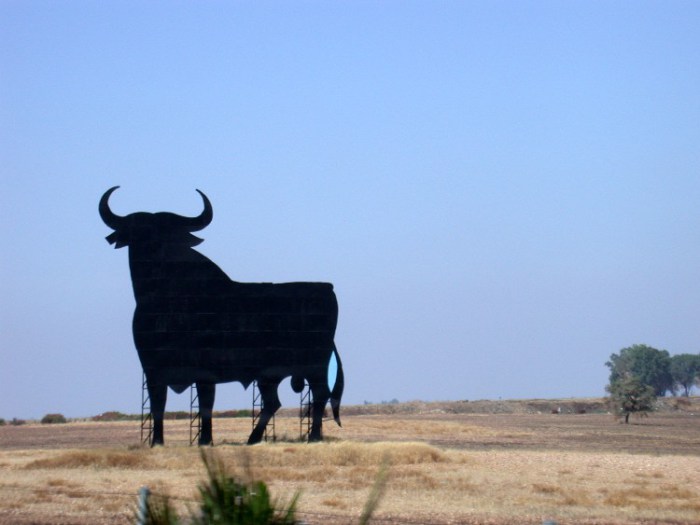From the followsummer archives. Spain, September 2004
Madrid to Cordoba: 396 kilometres
It is nearly 11 when we check out of our hotel and find the M506 that will direct us to the A4 south to Córdoba, Espana. We have to re-check our maps and routing because Madrid has changed all of the local road and highway numbering in the very recent past. We have already made some wrong choices when it comes to the expressways here.
The sun is burning its way through a hazy sky and already it is hot. We have repacked our bags and moved our last bit of clean clothes into the overnight bags before we repack the car. We anticipate doing a big laundry at the house we have rented next week in the Costa Brava with our former neighbours David and Kathryn from Toronto. Everything is going to get washed. The flat plain stretches out again as we leave Madrid. Once more the temperature continues to climb as we head south and soon is at 34 degrees. An hour or so into the trip we cross a huge craggy gorge and head down into gently rolling hills and valleys covered in acre upon acre of olive trees. Who knew we were so high up! We have moved from grapes to olives and even the farmhouses are different – whitewashed and huge; they stand out on the dusty brown hills.
We soon pass the Hotel Dulcinea on the highway followed quickly by the Restaurant Sancho Panza a little further down the road. We are both laughing at the obvious tourist grab when we see a huge sign telling us that we are heading into the “Tourist Trail of Don Quijote. Keep Left” (in Spanish, of course). The stark mix of the old white windmills and the huge 21st-century high tech windmills now planted on many of the hills is somewhat disconcerting. I wonder how the Don would have faired fighting one of those.
In Gaucho Country
We are in Gaucho country and we see people riding horses everywhere, their flat, wide-brimmed sombreros and elegant straw hats protecting them from the scorching sun. Families in horse-drawn caleches are out for a Saturday saunter. Or perhaps this is how they get around. A gaggle of boys, the youngest may 6 or 7, ride by on their dusty steeds. Every few miles (and this has been the case since we left Barcelona too) we come up against ‘El Toro’, a huge, and I mean huge, 3 or 4 storey, black cut-out of a bull, majestically holding its head up and arching his back, ready for battle. The first couple of times I saw one, I jumped. They rise up unexpectedly from around a narrow curve or you can spot them miles away, across the dusty brown plains. I have dubbed this unknown bull ‘El Toro’ and now, every time we see one standing proudly in a field, we yell out “El Toro”, in the same way the Japanese say “Godzilla!!”
Very Hot in Córdoba, Espana
There is no “El Toro” beer or “El Toro” wine associated with this big bull billboard but we assume that this is the Spaniards’ not so subtle way of telling you that you are in bullfighting country. In fact, I watched a little of the “Friday night fights” while we were in Madrid. It is a sport deep in tradition and ceremony and not for the faint of heart.
We make great time and arrive into Cordoba around 3 pm, in the middle of siesta, and spend an hour or so trying to find our hotel, driving down poorly marked streets that are barely wide enough for our not-very-big car. And it is very hot in Córdoba. We finally find the Hotel Maestre and like many of the houses and hotels in Cordoba, it is situated around a beautiful ‘patio’ with a lovely seating area and blue-tiled fountain. We have a small apartment suite here and we join the siesta and wait for the hot afternoon to change into a not so hot evening.
John and I have a big fight and eat perhaps one of the worst dinners we have had on our entire trip. The lesson is: don’t bring negative vibes into any restaurant you are going into.
Update:
Those “El Toro’s signs were erected in 1956 as part of an advertising campaign for the Osborne sherry and brandy company. They were on the point of disappearing altogether in 1988 following the introduction of a law banning advertising along roads outside of urban areas. Although the company has subsequently removed its name, a huge public debate about the disappearance of the signs ensued. It was argued that the black bulls had gone beyond their original marketing purpose and had become a decorative feature which was now an integral part of the Spanish landscape and a symbol of the country. As a result of this campaign, the regional parliament classified the bulls as official historical monuments, thus enabling the bulls to fight another day! (Source: The Green Guide – Andalucia)



Comments